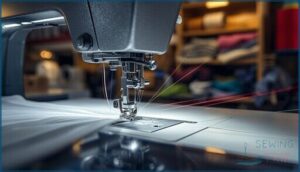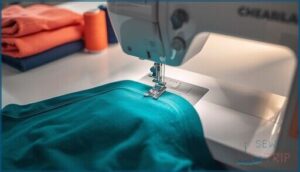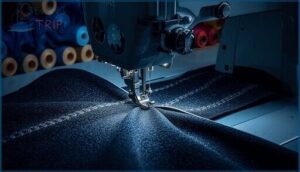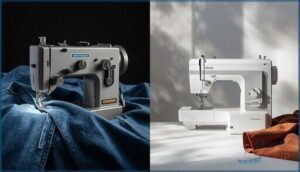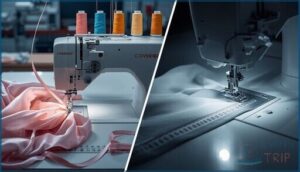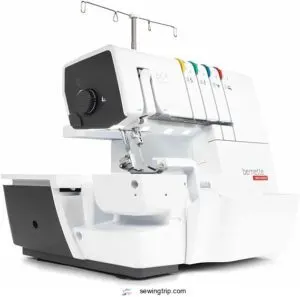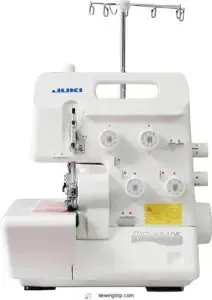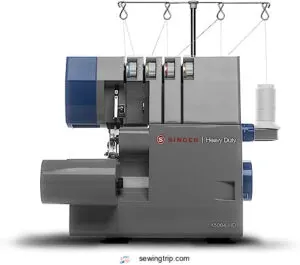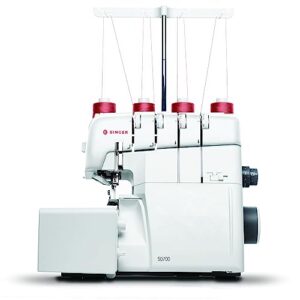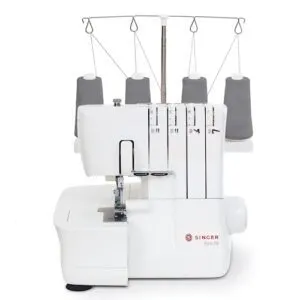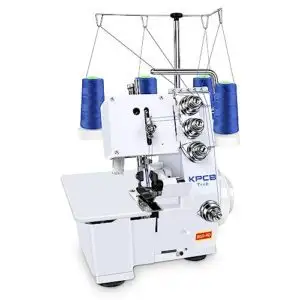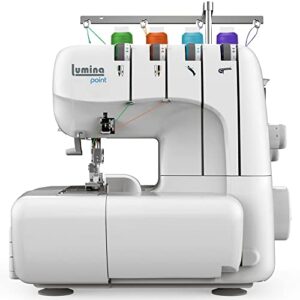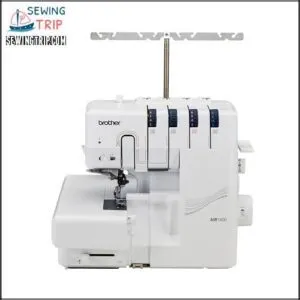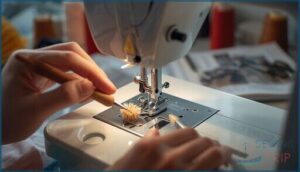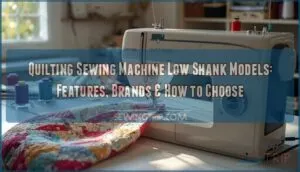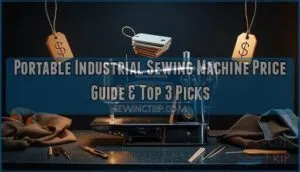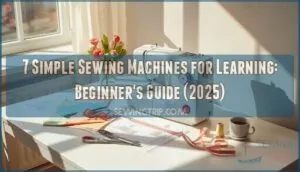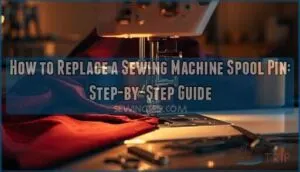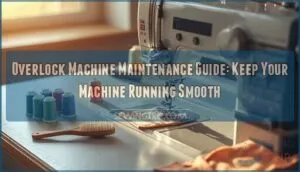This site is supported by our readers. We may earn a commission, at no cost to you, if you purchase through links.
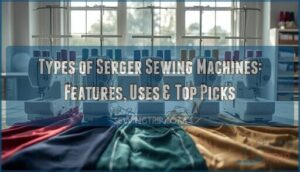
Most sewers don’t realize that the three-thread machine they call a serger is just one member of a much larger family. Walk into any garment factory, and you’ll spot at least five distinct types of serger sewing machines, each engineered for a specific task.
Overlock sergers trim and finish edges in one pass. Coverstitch machines create those professional double-needle hems you see on t-shirts. Combination units merge both functions, while chainstitch and safety stitch models handle stretchy seams that won’t snap under stress.
Your choice depends on whether you’re hemming knits, finishing woven seams, or building garments that need industrial-grade durability. Understanding these differences helps you match the right machine to your fabric and project requirements.
Table Of Contents
- Key Takeaways
- Types of Serger Sewing Machines
- Key Features of Each Serger Type
- Overlock Vs. Coverstitch Machines
- Choosing The Right Serger for Your Needs
- Top 10 Serger Sewing Machines Reviewed
- 1. Brother Computerized Sewing Machine
- 2. Bernette B64 Airlock Overlocker Machine
- 3. JUKI Portable Thread Serger Sewing Machine
- 4. Brother Coverstitch Serger Sewing Machine
- 5. Singer Heavy Duty Metal Frame Serger
- 6. Singer S0700 Air Threading Serger Kit
- 7. SINGER S14-78 Serger Sewing Machine
- 8. KPCB Serger Sewing Machine Overlock
- 9. Bruxel Lumina Serger Sewing Machine
- 10. Brother AIR1800 Air Threading Serger
- Maintenance and Troubleshooting Tips
- Frequently Asked Questions (FAQs)
- Conclusion
Key Takeaways
- Sergers aren’t one-size-fits-all—overlock machines trim and finish edges, coverstitch machines create professional hems on knits, and combination units merge both functions, so your choice hinges on whether you’re seaming, hemming, or needing versatility across different fabric types.
- Thread count and differential feed separate amateur results from pro-level seams—machines offering 2-5 thread configurations handle everything from delicate rolled hems to heavy-duty safety stitches, while differential feed settings between 0.7 and 2.0 prevent puckering on stretch fabrics and control gathering effects.
- Speed and construction quality directly impact your workflow—domestic sergers run 1,200-1,500 stitches per minute with metal frames that absorb vibration better than plastic, while features like air threading cut setup time from 15 minutes to under 2 minutes, eliminating the single biggest frustration for most users.
- Regular maintenance extends machine lifespan by 40% and prevents most common problems—cleaning lint after every few garments, replacing needles every 8-10 hours, swapping blades every 1-2 years, and adjusting tension one control at a time keeps your serger delivering clean seams without costly repairs or service calls.
Types of Serger Sewing Machines
You’ve probably heard the term “serger” tossed around in sewing circles, but there’s more than one type to choose from. Each machine fulfills a different purpose, whether you’re finishing seams, creating hems, or working with stretchy fabrics.
Let’s break down the main categories so you can figure out which one fits your projects best.
Overlock Sergers
Overlock sergers are the workhorses of seam finishing, trimming fabric edges while simultaneously stitching them together. These machines use multiple threads—commonly 2, 3, or 4—to create strong, flexible seams that prevent fraying. Leading brands like Brother and JUKI have introduced technological advances such as air-threading systems and performance metrics reaching 1,300 stitches per minute. Adjustable features improve a serger’s versatility.
- 2-thread overlock sergers excel at edging and flatlock seams on knits
- 4-thread models provide extra seam strength for high-stress areas
- Cutting blades in sophisticated sergers are 60% larger for efficient trimming
- Thread count options increase versatility across different fabric types
- Metal frame construction ensures durability during heavy-duty projects
Coverstitch Machines
While overlock sergers excel at edges, coverstitch machines tackle hems and topstitching on knit fabrics. You’ll find needle configurations ranging from 2-needle to 3-needle models, with the Bernette Funlock 42 delivering chainstitch machine functionality at 1,300 stitches per minute. Tension adjustments let you work with stretchy materials without puckering. Many models also offer adjustable stitch lengths for varied applications.
Coverstitch machine benefits include professional-looking double-sided seams—perfect for T-shirt hems and decorative uses on activewear.
Combination Sergers
If you want both capabilities in one unit, combination machines merge overlock and coverstitch functions. These adaptable combo machines deliver up to 87 stitch combinations at speeds reaching 1,500 stitches per minute.
Threading systems with color-coded paths simplify setup, though market pricing averages $1,000–$1,600. User demographics span hobbyists to small shops.
Advantages of combination machines include space savings and flexibility; disadvantages involve higher costs and complexity requiring detailed maintenance logs.
Chainstitch Machines
Moving beyond dual-function units, chainstitch machines specialize in elastic seams ideal for industrial usage on knits and activewear. You’ll find stitch options ranging from single to double needle configurations, operating at speeds up to 1,500 stitches per minute. Technological advancements like direct-drive motors eliminate belts, improving precision and reducing maintenance needs.
- Adjustable stitch length from 1.4 mm to 4 mm
- Accommodates medium to heavy fabrics including denim and workwear
- Servo motors improve stitch accuracy across variable speeds
- Combines cutting, sewing, and finishing in one operation
Safety Stitch Sergers
Safety stitch machines combine a two-thread chain stitch with a three-thread overlock, delivering durable seams that won’t fail under stress. You’ll achieve a professional finish on woven fabrics like workwear and activewear, with adjustable widths around 3.5 mm for fabric compatibility.
Industrial applications drive market trends, as these five-thread sergers dominate garment manufacturing. Adjustment techniques for stitch length and differential feed improve performance across medium to heavyweight materials.
Specialty Sergers (Heavy-Duty, Portable)
Beyond mainstream models, specialty serger options tackle unique demands. Heavy-duty sergers power through thick fabrics like denim and upholstery at 1,300 stitches per minute, with metal frames ensuring durability factors that matter for professional use.
Portable serger options weigh around 15 pounds, balancing portability needs with 1,500-stitch speeds. You’ll choose based on fabric capacity, user accessibility, and whether you’re hauling gear or anchoring a studio workspace.
Key Features of Each Serger Type
Not all sergers are built the same, and the features they offer can make or break your sewing experience. Each type brings something different to the table, from how many threads it uses to how smoothly it works with tricky fabrics.
Let’s break down the key features that define each serger type and what they mean for your projects.
Thread Options and Stitch Variety
You’ll find adaptable thread options across different machine types, ranging from 2 to 5 threads—some high-end models even support up to 10.
Thread count directly affects stitch types and applications: polyester thread suits most projects, while nylon excels with stretchy fabrics.
Thread weight influences needle compatibility; heavier threads require size 90/14 needles. Multiple threads create stronger, more flexible seams for varied stitch options and techniques.
Differential Feed and Fabric Handling
Differential feed acts like a traffic controller for fabric movement, using two independent feed dogs to manage how material flows under your presser foot. This mechanism prevents puckering on delicate woven fabrics and stops stretchy fabrics from warping.
You’ll adjust settings between 0.7 and 2.0—higher ratios create gathering effects on knit fabric, while lower settings maintain seam integrity by controlling stretch during stitching.
Cutting Blades and Seam Finishing
Your serger’s cutting blades work like precision scissors—an upper knife moves vertically while a lower blade stays stationary, trimming fabric edges as you sew. This blade system creates clean seams by cutting and finishing simultaneously.
You’ll adjust the cutting width to control how much fabric you remove, which directly impacts your seam techniques and overall sewing quality.
Regular blade maintenance prevents fraying on fabric edges and keeps your overlock sergers performing at their best.
Speed, Durability, and Construction
When you’re pushing a serger through layers of denim, you’ll quickly learn why machine durability and strength matter. Stitching speed ranges from 1,300 stitches per minute on domestic models to 7,000 on industrial machines—stitch speed impacts your entire workflow.
Consider these construction essentials:
- Frame material matters: metal frames absorb vibration better than plastic
- Blade durability factors: carbon steel blades cut cleanly through multiple layers
- Heavy-duty construction: cast iron bodies maintain precision during continuous operation
- Portable serger build: lightweight designs balance durability with transportability
Your serger machine’s performance depends on how these elements work together under real sewing conditions.
Ease of Threading and Maintenance
Threading systems separate frustrating machines from ones you’ll actually use. Air threading ease cuts setup time from 15 minutes to under 2, while color-coded paths reduce threading errors by 31%.
Here’s your maintenance reality:
| Task | Frequency | Impact |
|---|---|---|
| Needle replacement | After each project | Prevents 89% of stitch issues |
| Blade maintenance | Every 5-7 years (light use) | Eliminates 21% of cutting problems |
| Routine maintenance | Biweekly cleaning | Reduces service calls 25% |
Error reduction matters—44% of jams come from incorrect threading sequences alone.
Overlock Vs. Coverstitch Machines
Overlock and coverstitch machines might look similar, but they handle completely different jobs in your sewing workflow. Understanding how each one forms stitches and where it shines will help you decide which machine deserves space on your workbench.
Let’s break down the key differences so you can choose the right tool for your projects.
Differences in Stitch Formation
When you compare stitch formation, the differences become clear. Overlock durability comes from two to five multiple threads interlacing around fabric edges, creating strong seams that handle stress. Coverstitch hems use parallel needle threads with a looper underneath—no cutting blade involved. Chainstitch flexibility relies on a single needle and looper, while safety stitching combines both chainstitch and overlock for maximum strength.
| Stitch Types | Needle Options & Formation |
|---|---|
| Overlock | 2-4 needles, edge encapsulation |
| Coverstitch | 2-3 needles, parallel topstitching |
| Safety Stitch | Combined chainstitch + overlock |
Specialty variations expand these core formations, giving you more control over stitch quality.
Ideal Uses for Each Machine
Understanding stitch formation helps you pick the right tool. Overlock sergers excel at garment construction, racing through T-shirts and sportswear at speeds hitting 1,700 stitches per minute. Coverstitch machines nail professional hems on activewear and leggings. Chainstitch machines handle stretchy seams in denim and bags. Combination machines offer both functions, perfect when space is tight.
| Machine Type | Best For | Fabric Adaptability |
|---|---|---|
| Overlock | Seam finishing, home decor | Knits and wovens |
| Coverstitch | Hemming stretchy garments | Primarily knits |
| Combination | Multi-task projects | Wide range |
| Chainstitch | Durable flexible seams | Lightweight to heavyweight |
| Safety Stitch | Industrial sewing strength | Heavy-duty applications |
Decorative applications work beautifully with specialty threads on overlock models.
Benefits and Limitations
Each machine type brings trade-offs you’ll want to weigh. Overlock sergers deliver time savings and excellent finish quality at entry-level prices around $200, but they won’t handle hems. Coverstitch machines nail professional topstitching yet can’t finish raw edges. Combination serger advantages include versatility, though the learning curve steepens and maintenance needs multiply. Cost factors rise with added features, sometimes hitting $8,000 for top models.
| Machine Type | Key Benefit | Main Limitation |
|---|---|---|
| Overlock | Fast seam finishing | No hemming capability |
| Coverstitch | Professional hems | Can’t finish edges |
| Combination | Does both tasks | Complex threading |
When to Choose Each Type
Your fabric type and stitch requirements guide the choice. Pick overlock sergers when you’re finishing raw edges on knits or wovens—they handle everyday garment construction beautifully. Choose coverstitch machines if professional hems on stretch fabrics matter most. Budget constraints and user experience levels also weigh in. Combination machines suit those tackling project complexity across multiple garment categories, though they demand patience during setup.
| Decision Factor | Choose Overlock | Choose Coverstitch |
|---|---|---|
| Primary Need | Edge finishing, seaming | Hemming, topstitching |
| Fabric Focus | Knits, wovens, fraying fabrics | Stretch knits, activewear |
| Budget Range | $200–$600 entry models | $300–$1,200 specialized |
| Skill Level | Beginner-friendly threading | Moderate threading complexity |
Choosing The Right Serger for Your Needs
Finding the right serger isn’t about choosing the fanciest model—it’s about matching the machine to what you’ll actually use it for. Your projects, workspace, and skill level will all point you toward different features and price ranges.
Let’s break down the key factors that’ll help you make a smart choice.
Project and Fabric Considerations
When you’re weighing serger options, your fabric types and project complexity make or break the decision. Here’s what matters most:
- Fabric weight dictates motor power—thick quilted materials need at least 90 watts for consistent feed.
- Stretchy fabrics demand polyester or nylon thread; cotton breaks 30% more often under stress.
- Knit fabrics work best with ballpoint needles, reducing damage by 78%.
- Stitch suitability varies—two-thread sergers handle 72% of lightweight knits, while four- or five-thread models secure 89% of heavy-duty projects.
- Thread choice affects seam durability—polyester accounts for 98% of activewear seams.
Match your serger’s capabilities to your fabric handling needs for professional results.
Machine Size and Portability
Your workspace sets real limits on what you can use comfortably. Portable serger options weighing 10-16 pounds let you tackle projects anywhere, while heavy-duty models approaching 20 pounds demand dedicated space.
Compact size matters—most portables measure 11×14×12 inches, fitting countertops easily. Travel sergers with ergonomic design and carrying grips deliver portability benefits without sacrificing stitch quality. Space-saving dimensions don’t compromise performance for portable use.
Budget and Feature Priorities
Your budget directly shapes which features you’ll actually use daily. Entry-level sergers under $350 cover basics, while mid-range models ($400-$1,000) add air-threading and speed.
Consider these budget tiers and feature trade-offs:
- Entry-level: Manual threading, 1,200 stitches/minute, 6 stitch types
- Mid-range: Color-coded guides, LED lighting, differential feed
- High-end: Computerized controls, 1,500 stitches/minute, 20+ stitches
- User priorities: 60% want automated threading over stitch variety
- Performance metrics: Heavier machines offer durability; portables sacrifice weight
Match essential features to your actual project needs, not wish lists.
Beginner Vs. Advanced User Needs
Your learning curve shapes which serger you’ll actually master. Beginners usually need simpler threading—75% prioritize easy mechanisms—and slower machine speeds around 1,200 stitches per minute for control.
Skilled users gravitate toward higher stitch complexity with 5-7 thread options and faster speeds up to 1,800 stitches per minute.
Maintenance proficiency differs too: 70% of beginners want minimal upkeep, while experienced sewers confidently handle routine adjustments.
Portability needs also vary—beginners favor lightweight models under 15 pounds.
Top 10 Serger Sewing Machines Reviewed
Now that you know what to look for in a serger, let’s examine some specific models that deliver real performance.
These ten machines represent different price points, feature sets, and specialties, so you can find one that matches your sewing style. Each review highlights what makes the machine stand out and who it’s best suited for.
1. Brother Computerized Sewing Machine
You’ll find the Brother Computerized Sewing Machine stands as a powerhouse in the sewing machines category, though it’s not technically a serger. With 165 built-in stitches and digital stitch control, you can tackle diverse projects with precision. The automatic needle threader and LED lighting make setup quick, even in dim workspaces.
Its versatility spans garments to quilting, while its market position reflects decades of technological innovations. Brother’s reliability shines here, offering features like free-arm capability and drop feed for creative freedom. It’s ideal for sewers wanting computerized convenience without serger-specific functions.
Best For: Beginners and enthusiasts who want a versatile, easy-to-use machine for everyday sewing, quilting, and garment construction with lightweight to medium fabrics.
- 165 built-in stitches with an LCD display make it easy to find the right stitch for any project, from basic repairs to decorative work.
- Automatic needle threader and drop-in bobbin save time and frustration, especially for new sewers still learning the ropes.
- Comes with 8 presser feet, a wide table, and free-arm capability, giving you flexibility for everything from sleeves to larger quilts.
- Not built for heavy-duty work—struggles with thick or dense materials like denim or upholstery fabric.
- The reverse button and narrow threading area can feel awkward during routine tasks like changing needles.
- Only designed for US use, so the warranty won’t cover you if you’re using it elsewhere.
2. Bernette B64 Airlock Overlocker Machine
The Bernette B64 Airlock overlock serger shifts gears with its automatic air threading system, pushing looper setup into one-touch territory. You get 16 stitch options, from flatlock to rolled hems, with Micro Thread Control managing tension adjustments as fabric thickness changes.
Its 1,300 SPM speed manages heavy workloads, while five LED lights and a knee-lifter Free Hand System boost user comfort during marathon sessions. Safety features include an automatic shutoff when the cover opens.
At $1,499, it balances professional performance with accessible serger machine features for serious home sewers.
Best For: Home sewers and quilters who want professional serging results without the hassle of manual threading, especially those working with varied fabrics and long projects.
- One-touch air threading system eliminates the frustration of manual looper threading, saving setup time on every project.
- Micro Thread Control automatically adjusts tension based on fabric thickness, so you get consistent stitches without constant manual tweaking.
- High 1,300 SPM speed paired with five LED lights and a knee-lifter system lets you power through large projects comfortably and efficiently.
- Some users report the air threading system doesn’t always work reliably, requiring manual intervention despite the automated feature.
- Warranty coverage issues arise when purchasing from non-authorized dealers, potentially leaving you without support.
- Build quality doesn’t quite match higher-end Bernina models, with occasional operational noise complaints from users.
3. JUKI Portable Thread Serger Sewing Machine
JUKI’s MO654DE portable thread serger punches above its weight class, delivering 1,500 SPM with industrial-grade tension dials wrapped in a 15.2-pound frame. You’ll navigate 2/3/4 thread configurations using color-coded guides, though threading challenges still trip up beginners despite the automatic rolled hem feature.
Its differential feed (0.7 to 2.0 ratio) works with stretch fabrics without puckering, while maintenance ease shines through accessible covers for quick lint removal.
At $438.93 on Amazon, stitch quality rivals shop-floor JUKI machines, making serger machine reviews consistently rank this portable sewing machine among top home-use picks.
Best For: Home sewers and small business owners who need professional-quality finishing on garments and home decor projects without dedicating space to industrial equipment.
- Blazing 1,500 SPM speed with industrial tension dials gives you shop-floor performance in a portable 15-pound package that moves easily between workspaces.
- Differential feed from 0.7 to 2.0 handles everything from delicate knits to heavy canvas without puckering, plus the automatic rolled hem feature switches stitch types in seconds.
- Accessible front and side covers make cleaning straightforward, while the quiet motor and suction cup base keep vibration minimal during extended sessions.
- Threading the upper looper remains tricky for beginners even with color-coded guides, often requiring YouTube tutorials or a serger reference book to master.
- No built-in fabric scrap bin means you’ll clean up trimmed edges manually after each project, and the standard lighting struggles in dim sewing rooms.
- The instruction manual glosses over advanced stitch variations, leaving you to figure out tension adjustments through trial and error on scrap fabric.
4. Brother Coverstitch Serger Sewing Machine
Brother’s 2340CV CoverStitch Serger shifts focus from overlock to topstitch superiority, running 1,100 SPM through a metal frame you’ll appreciate during multi-hour hemming sessions.
Your fabric compatibility spans swimsuit Lycra to hoodie fleece using 2-3-4 thread configurations, with tension adjustment dials controlling wide, narrow, and triple coverstitch formations.
Color-coded threading reduces setup frustration, though user experience varies—some report skipped stitches while others praise stitch quality on stretch fabrics.
At $549.99, warranty support includes 25-year coverage, positioning this coverstitch machine between beginner-friendly and professional-grade performance.
Best For: Sewers who need professional-looking hems and decorative stitching on stretch fabrics like athletic wear, swimsuits, and knits.
- Fast 1,100 stitches per minute with adjustable stitch length and width for versatile coverstitching projects.
- Color-coded threading system and snap-on presser feet make setup easier than traditional machines.
- Sturdy metal frame construction backed by a 25-year limited warranty for long-term reliability.
- Multiple users report skipped stitches, thread breakage, and tension adjustment issues across different fabrics.
- Quality control concerns suggest some units may arrive with performance problems out of the box.
- At $549.99, the price point may be steep given the reported reliability inconsistencies.
5. Singer Heavy Duty Metal Frame Serger
Singer’s HD0450S delivers 1,300 SPM through a metal frame construction that supports thick fabrics without the flex issues you’ll find in plastic-bodied sergers. Color-coded threading paths simplify setup, though manual threading lacks air-assist convenience.
Your 2-3-4 thread configurations cover six stitch types, including rolled hems and flatlocking, while the 60% larger cutting blade processes upholstery-weight materials that choke lesser overlock sergers.
At $256.99 with 25-year warranty coverage on the sewing machine head, this heavy-duty model bridges budget constraints and professional fabric handling demands.
Best For: Sewers who need a reliable, budget-friendly serger that can handle both delicate fabrics and heavier materials like denim or upholstery without sacrificing speed or stitch quality.
- Metal frame construction and stainless steel bed plate provide solid stability at high speeds, preventing the vibration and wobbling common in lighter sergers.
- 1,300 stitches per minute with 2-3-4 thread capability and six stitch types give you plenty of flexibility for everything from rolled hems to flatlocking without constantly adjusting settings.
- 25-year warranty on the sewing machine head and a 60% larger cutting blade mean you’re getting long-term durability and the ability to slice through thick fabrics in one pass.
- Manual threading can be frustrating and time-consuming, especially for beginners, since there’s no air-threading feature to speed up the process.
- Instructions are often vague or unclear, which can make initial setup and troubleshooting harder than it should be.
- Some users report quality control issues or performance problems that don’t show up until after the return window closes, leaving you stuck with a machine that underperforms.
6. Singer S0700 Air Threading Serger Kit
The SINGER S0700 Serger revolutionizes looper setup with air threading ease, allowing you to thread in half the time compared to manual systems. With 15 stitch options and 4-3-2 thread capability, this machine handles everything from rolled hems to decorative flatlock.
It features a differential feed to prevent puckering on knits and operates at 1,300 SPM for efficient project completion. Weighing 13.9 pounds and measuring 11.4″D x 13.7″W x 11.8″H, it balances portability with stability.
The serger is backed by a 25-year warranty, ensuring reliability. However, users may need patience with the needle threader’s occasionally clunky action.
Best For: Home sewers and crafters who want professional-quality seams and hems without the frustration of manual threading, especially when working with knits and stretch fabrics.
- Air threading system cuts setup time in half, making looper threading quick and hassle-free compared to traditional sergers.
- Differential feed prevents puckering and stretching on knits, while the 1,300 SPM speed handles projects efficiently.
- 25-year warranty provides long-term peace of mind, and the 15 stitch options offer versatility for both utility and decorative work.
- Needle threader can feel clunky and fragile during use, requiring a gentle touch to avoid potential breakage.
- Tension disks may arrive loose and need adjustment before achieving consistent stitch quality.
- At 13.9 pounds, it’s heavier than some competing sergers, which may affect portability for classes or sewing groups.
7. SINGER S14-78 Serger Sewing Machine
The SINGER S1478 Serger delivers stitch versatility with 2-3-4 thread options and 12 stitch types, making it adaptable for various serger machine features. You’ll appreciate the speed metrics: 1,200 stitches per minute for quick project turnarounds.
The overlock sergers in this category excel at rolled hems and stretch fabric handling. Threading challenges exist initially, but user experience improves with practice.
Market reception is positive, with sewers praising its value and performance balance. The free arm simplifies cuffs and sleeves, while LED lighting enhances visibility during detailed work.
Best For: Beginners and experienced sewers looking for a fast, versatile serger that handles stretch fabrics and decorative hems without breaking the bank.
- Speedy 1,200 stitches per minute with 2-3-4 thread versatility and 12 stitch types for professional seams and rolled hems.
- Differential feed prevents fabric puckering on knits and stretchy materials, while the free arm makes sleeves and cuffs easy to tackle.
- LED lighting and included accessory kit provide great visibility and essential tools right out of the box at a solid value price point.
- Threading can be tricky for beginners, and there’s no physical manual included—you’ll need to download it online.
- No dust cover comes with the machine, and finding replacement feet can be frustrating with limited information provided.
- Some users report tension inconsistencies that require regular adjustments and maintenance to keep stitches looking clean.
8. KPCB Serger Sewing Machine Overlock
The KPCB Serger Sewing Machine offers 3-4 thread capability with color-coded threading to ease setup challenges. Its 1,200 stitches-per-minute speed works efficiently with various fabrics, from chiffon to denim.
Threading challenges persist despite visual guides, and some users report durability concerns with tension adjustments over time. Stitch quality remains consistent when the machine is properly maintained.
At 18.6 pounds, portability review feedback is positive for home workshops. The value proposition stands out—this overlock serger delivers essential features without premium pricing, making it practical for budget-conscious sewing spaces.
Best For: Home sewists and small workshop owners looking for an affordable serger that handles multiple fabric types without the premium price tag.
- Fast 1,200 stitches-per-minute speed with 3-4 thread configurations makes quick work of everything from lightweight chiffon to heavy denim.
- Color-coded threading system and built-in diagram reduce setup frustration, especially helpful for beginners learning to serge.
- Compact 18.6-pound design with carrying handle fits easily in home sewing spaces and stores away when not in use.
- Threading can still be tricky despite visual aids, and tension adjustments require patience to get right.
- Quality control issues pop up occasionally—some units arrive with loose knives or faulty LED lights.
- Regular oiling and maintenance needed to keep performance consistent, plus customer service response times can lag.
9. Bruxel Lumina Serger Sewing Machine
Compact design meets industrial-grade construction in the Bruxel Lumina Serger Sewing Machine, weighing 17.6 pounds with a metal frame built for stability. Its color-coded threading system simplifies setup, and you’ll appreciate the 2/3/4 thread capability for varied stitch quality.
User feedback consistently rates it 4.8 out of 5 stars, with over 90% praising easy adjustments and cleaning. Fabric handling excels through differential feed controls, preventing puckering on knits and wovens.
At 1,250 stitches per minute, this overlock serger delivers professional results—machine durability that holds up under extended use.
Best For: Home sewers and garment makers who need reliable serging for professional-looking seams and edges, from beginners learning the basics to experienced crafters tackling heavy fabrics.
- Color-coded threading system and pre-threaded setup make it genuinely easy to get started, even if you’ve never used a serger before.
- Handles heavy-duty fabrics like denim and canvas without losing speed or stitch quality at 1,250 stitches per minute.
- Differential feed controls prevent fabric puckering and stretching, giving you clean results on everything from knits to wovens.
- Some users report the manual instructions aren’t clear enough, which can make troubleshooting frustrating.
- Component pieces may feel cheaper than expected given the overall build quality of the metal frame.
- Requires regular cleaning and oiling to maintain performance, so it’s not completely maintenance-free.
10. Brother AIR1800 Air Threading Serger
Threading loopers in under 30 seconds sounds impossible—until you use the Brother AIR1800 Air Serger’s jet air threading system. A single button activates the air-blast mechanism, feeding both upper and lower loopers without manual work.
This Brother serger machine accommodates 2/3/4 thread configurations with stitch versatility spanning flatlock, overlock, and rolled hems. Metal construction ensures build quality that survives years of garment work, while LED error lights and color-coded guides boost ease of use.
At 1,300 stitches per minute with 4.8-star ratings, market performance proves its reliability.
Best For: Experienced sewers and serger beginners who want professional finishing on stretchy fabrics without the frustration of manual looper threading.
- Jet air threading cuts looper setup to under 30 seconds, letting you swap thread colors fast without feeding tubes manually.
- Metal chassis and 1,300 stitches per minute deliver durability and speed that handle heavy garment construction and quilting projects.
- LED error lights and color-coded guides catch mistakes before they happen, plus the differential feed (0.7mm to 2.0mm) tames tricky knits and elastic materials.
- Limited to 120 volts for U.S. use only—running it overseas voids the warranty entirely.
- Some users report the air threading mechanism doesn’t always work perfectly, occasionally requiring manual adjustments.
- No collection bin for trimmed fabric scraps, so you’ll need to clean up clippings as you sew.
Maintenance and Troubleshooting Tips
Your serger won’t maintain itself, but keeping it in top shape doesn’t require a mechanical engineering degree. Regular care prevents most problems and extends your machine’s working life by years.
Let’s walk through the essential maintenance tasks and troubleshooting steps that’ll keep your serger running smoothly.
Cleaning and Oiling Your Serger
Think of your serger as a high-performance engine—routine maintenance keeps it humming. You’ll want to tackle lint removal after every couple of garments to prevent skipped stitches and tension headaches. Here’s your game plan:
- Brush away lint buildup from feed dogs and loopers
- Vacuum tight spaces a brush can’t reach
- Check your manual for oiling points (not all models need it)
- Apply one drop of oil per designated spot after 8-10 hours of use
- Wipe exterior surfaces with glass cleaner and soft cloth
Neglect effects are real—lint absorbs oil, causing friction and premature wear. Following this routine can extend your machine’s lifespan by up to 40%, keeping those professional seams coming for years.
Replacing Needles and Blades
After consistent cleaning, you’ll need needle replacement every 8-10 hours of sewing—sooner if you spot skipped stitches or fabric puckering. Check for bent tips or dull edges regularly.
Blade replacement signs include ragged cuts and fabric bunching, usually after 1-2 years.
Use needles matching your fabric (ballpoint for knits, standard 80/12 for wovens). Changing blades safely requires just a screwdriver and 10 minutes of routine maintenance.
Adjusting Tension and Differential Feed
Once you’ve swapped needles and blades, mastering tension balance and differential feed ratios transforms your serger’s performance. Standard adjustment guidelines recommend starting at midpoint settings—commonly 3-5 for thread tension and 1.0 for differential feed.
Here’s your troubleshooting roadmap:
- Adjust looper tensions first before touching needle tension to avoid misleading stitch defects
- Change one control at a time in 0.1-0.2 increments to isolate fabric control issues
- Loosen tension 15-20% for heavy fabrics while tightening if lower looper threads show topside
Fabric type impact matters greatly—stretch knits need differential feed below 1.0, preventing seam wave, while settings above 1.5 intentionally gather lightweight materials.
Common Issues and Quick Fixes
Beyond adjustment dials, you’ll face recurring serger machine troubleshooting scenarios. Thread breakage strikes 35% of users—rethread from the lower looper when tangles occur. Skipped stitches? Replace needles every 8-10 hours.
Uneven seams usually mean tension disc buildup, so grab your lint brush. Blade issues show up as ragged edges—swap them every 2-3 years.
Fabric feed problems? Check that your presser foot is fully lowered and clear stitch fingers of debris.
Maximizing Machine Lifespan
Regular servicing every year prevents worn-out lubricants from damaging internal parts. Proper storage in climate-controlled spaces stops rust—basements cut lifespan by half. Your needle replacement schedule matters: swap every 6-8 hours of stitching. Blade maintenance every two years keeps cuts clean. Oiling practices after deep cleaning prevent seizure, but don’t overdo it—excess oil attracts lint that clogs mechanisms.
Follow these four routine serger maintenance steps:
- Schedule professional servicing annually for frequent users
- Replace needles after 6-8 hours of active sewing
- Oil looper shafts sparingly after major cleanings
- Store your machine indoors with stable temperature
Frequently Asked Questions (FAQs)
Can sergers replace regular sewing machines completely?
Sergers can’t replace sewing machines completely. While overlock sergers excel at seam finishing, they lack project versatility for zippers and buttonholes.
Most sewists need both, despite cost implications and skill requirements for each machine type.
What thread types work best for sergers?
Think of serger thread as your seam’s backbone—polyester thread offers strength and stretch, nylon thread suits knits, cotton thread works for natural fabrics, and core-spun thread balances durability with flexibility.
How difficult is learning to thread a serger?
Threading a serger feels intimidating at first, but color-coded threading guides and air threading benefits simplify the process. Most threading frustration stems from looper paths, though learning curve tips and practice overcome threading fear quickly.
Do all sergers include built-in cutting blades?
Most overlock sergers feature built-in cutting blades, but coverstitch machines don’t include them.
Some specialty sergers and entry-level models skip blades to reduce costs.
Blade engagement varies by machine type and intended use.
Are serger stitches strong enough for upholstery?
Yes, four-thread overlock and safety stitch sergers handle upholstery well. Polyester thread seams withstand 30–40 lbs tensile force, meeting industry seam standards for durable seams on heavy-duty fabrics through proven long-term performance.
Conclusion
Finding the right fit among types of serger sewing machines isn’t rocket science once you know what each one does. Match your machine to your fabric—overlocks for clean edges, coverstitches for hems, combinations for versatility.
Consider your skill level, budget, and project scope before you buy. Regular maintenance keeps any serger running smoothly for years.
The difference between frustration and perfect seams often comes down to choosing the machine that actually suits your workbench.
- https://www.thesprucecrafts.com/understanding-serger-or-overlocking-sewing-machine-2978199
- https://threadsmonthly.com/how-to-choose-serger-overlocker/
- https://sewingmachineman.substack.com/p/the-definitive-guide-to-sergers
- https://marketintelo.com/report/serger-machine-market
- https://insights.made-in-china.com/How-Frequently-Should-You-Service-Your-Shoe-Sewing-Machine-to-Meet-User-Demands_VflTgwiCaEIp.html

